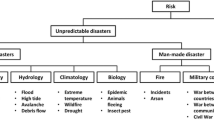Abstract
Cultural heritage assets, the bearers of historic evidence, are under continuous pressure from change, deterioration, and destruction. Therefore, there is a need to identify and monitor the related risks and to develop appropriate measures for increasing the resilience of cultural heritage. The activities for establishing a European system for data collection and its application in the field of preventive conservation are an ongoing process, where the issue of risks and resilience is well addressed. Recently, there has been an interest in developing a model of built heritage resilience related to mitigation and reaction on sudden environmental impacts, following the resilience models of contemporary buildings. However, these models cannot be simply extended to heritage buildings because of their specific character. In this chapter, a contribution to an acceptable resilience model of heritage buildings is presented.
Access this chapter
Tax calculation will be finalised at checkout
Purchases are for personal use only
Preview
Unable to display preview. Download preview PDF.
Similar content being viewed by others
References
S.B. Manyena, The concept of resilience revisited. Disasters 30(4), 434–450 (2006)
C.B. Field et al. (eds.), Managing the Risks of Extreme Events and Disasters to Advance Climate Change Adaptation: Special Report of the Intergovernmental Panel on Climate Change (Cambridge University Press, Cambridge, 2012)
R. Jigyasu et al., Heritage and Resilience: Issues and Opportunities for Reducing Disaster Risks (UNESCO Worrld Heritage Centre, Geneva, 2013), p. 52
Assembly, UN General, The future we want. Resolution 66, 288 (2012)
Thimphu Document 1, Outcome of the International Conference on Disaster Management and Cultural Heritage, Thimphu, Bhutan, 2010
B. Vodopivec et al., Renovation priority ranking by multi-criteria assessment of architectural heritage: the case of castles. Int. J. Strateg. Prop. Manag. 18(1), 88–100 (2014)
I.J. Bateman, R.K. Turner, Valuation of the environment, methods and techniques: the contingent valuation method, in Sustainable Environmental Economics and Management: Principles and Practice (Belhaven Press, London, 1993), pp. 120–191
R. Eppich (ed.), Cultural Heritage, Landscape & Rural Development: Good Practice, Methodology, Policy Recommendations and Guidelines for Rural Communities: HISTCAPE: Historic Assets and Related Landscapes (2014), http://histcape.eu
V. Rajčić, Croatian traditional vernacular wooden architecture, in HISTCAPE and Beyond, ed. by B. Vodopivec et al. (2014), pp. 9–14
R. Žarnić et al., Heritage Protection. From Documentation to Interventions (2012), http://www.eu-chic.eu
Council of Europe, Guidance on Inventory and Documentation of the Cultural Heritage, Prepared by Ad Hoc Group for Inventory and Documentation Within the Technical Co-operation and Consultancy Programme (Council of Europe Publishing, Strasbourg, 2009), http://archives.icom.museum/object-id/heritage/core.html
R. Thornes, E. Fink, Protecting Cultural Objects Through International Documentation Standards: A Preliminary Survey (Getty Art History Information Program, Santa Monica, CA, 1995)
E.E. Fink, in Sharing Cultural Entitlements in the Digital Age: Are We Building a Garden of Eden or a Patch of Weeds? Museums and the Web Conference, pp. 5–8, 1997
M. Ioannides et al., in Standards in Cultural Heritage: The Missing Grammar for the Digital Documentation of the Past. XX CIPA Symposium, 2005
M. Ioannides, R. Žarnić, V. Rajčić, R. Davies, G. Papagiannakis, M. Hagedorn-Saupe, in How to Manage (Model, Archive, Retrieve, Preserve and Exchange) Cultural Heritage Data on 3D Assets and Knowledge? Communication to ICOMOS Board, pp. 1–3, 2016
F. Hofmann et al. (ed.), COST Action C5: Urban Heritage—Building Maintenance: Final Report (EUR 20447, EC Directorate-General for Research, Brussels, 2002), http://bookshop.europa.eu/en/cost-action-c5-pbKINA20447/?CatalogCategoryID=ANIKABstUgUAAAEjCJEY4e5L
M.B. Bagbancı, Examination of the failures and determination of intervention methods for historical Ottoman traditional timber houses in the Cumalıkızık Village, Bursa–Turkey. Eng. Fail. Anal. 35, 470–479 (2013)
A. Davey, Maintenance and Repair Techniques for Traditional Cast Iron-Short Guide (Historic Scotland, 2013), pp. 2–4, 6, http://conservation.historic-scotland.gov.uk/publication-detail.htm?pubid=9908
P. Antoniou, in Concern for Disaster Risk Reduction in the Management of World Heritage Properties. A research through the archives of the World Heritage Centre, UNESCO, 2012
M. Bruneau et al., A framework to quantitatively assess and enhance the seismic resilience of communities. Earthq. Spectra 19(4), 733–752 (2003)
Acknowledgments
The ongoing research work that is the basis of this chapter is supported by the European Commission (EC). The research through the Initial Training Networks for Digital Cultural Heritage: Projecting our Past to the Future (ITN-DCH, FP7-PEOPLE-2013-ITN-Marie-Curie Action: “Initial Training Networks” Project reference 608013 funded under FP7-PEOPLE from 2013-10-01 to 2017-09) engage early-stage researchers from different countries. The research is partially based on results of EC-financed Coordinated Action EU-CHIC (FP7-ENV-2008-1 no. 226995, 2009/12). The future results of the recently started Horizon 2020 project INCEPTION—Inclusive Cultural Heritage in Europe through 3D semantic modelling (H2020-REFLECTIVE-7-2014 no: 665220, 20152019)—will contribute to intended further development of the resilience model. The authors acknowledge the support of the European Commission to their research.
Author information
Authors and Affiliations
Corresponding author
Editor information
Editors and Affiliations
Rights and permissions
Copyright information
© 2017 Springer International Publishing AG
About this chapter
Cite this chapter
Zarnic, R., Rajcic, V., Vodopivec, B. (2017). Data Collection for Estimation of Resilience of Cultural Heritage Assets. In: Ioannides, M., Magnenat-Thalmann, N., Papagiannakis, G. (eds) Mixed Reality and Gamification for Cultural Heritage. Springer, Cham. https://doi.org/10.1007/978-3-319-49607-8_11
Download citation
DOI: https://doi.org/10.1007/978-3-319-49607-8_11
Published:
Publisher Name: Springer, Cham
Print ISBN: 978-3-319-49606-1
Online ISBN: 978-3-319-49607-8
eBook Packages: Computer ScienceComputer Science (R0)




